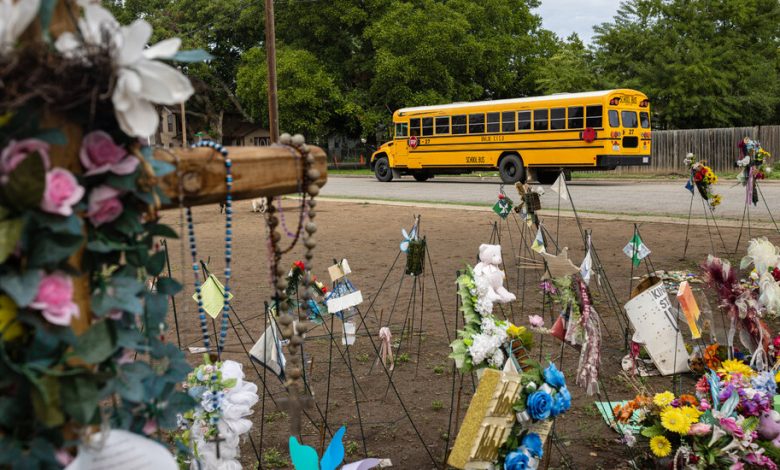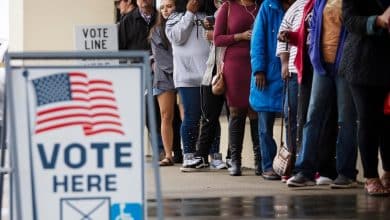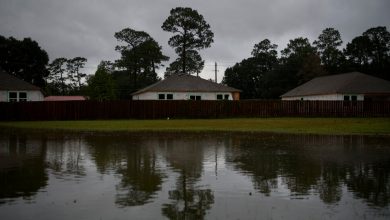After Uvalde, Texas State Police Revise Training for Mass Shootings

HOUSTON — In the wake of a massacre at an elementary school in the city of Uvalde, the Texas Department of Public Safety has quietly adopted a much more aggressive approach to handling school shootings, according to a July email obtained by The New York Times.
The department has also referred five of its officers to the state inspector general for a formal investigation following an internal inquiry into the actions and inaction by state police officers at Robb Elementary School during the shooting on May 24, according to a spokesman. The officers face possible suspension, demotion or firing.
Taken together, the moves amount to an acknowledgment that while the director of the state police, Steven McCraw, has publicly laid blame for the failed police response on the former Uvalde schools police chief, Pete Arredondo, other officers at the scene have also been found to share responsibility.
The change in protocol, adopted without fanfare less than two months after the shooting, means that Department of Public Safety officers responding to an active shooting in a school would be operating under guidelines much different from those followed in Uvalde, where scores of officers did not rush to attack the gunman but instead considered him to be barricaded and contained, a situation that allowed for a more prolonged response.
Minutes after the shooting began inside Robb Elementary school, officers began arriving. But they did not enter the classrooms to confront the gunman until more than an hour later, a delay in treating the wounded children and teachers that has led to overlapping state and federal investigations.
Ultimately, Border Patrol agents stormed the classrooms and killed the gunman.
After initially rushing toward the shooting, Mr. Arredondo, who was fired last week, began treating the gunman, who had temporarily stopped firing inside a pair of connected classrooms, as a barricaded subject. Under that kind of response protocol, officers could theoretically focus on negotiating a surrender or strategizing an entry.
Mr. McCraw has called that the “wrong decision.” In his email, he described how state troopers would now be expected to respond.
“D.P.S. officers responding to an active shooter at a school will be authorized to overcome any delay to neutralizing an attacker,” Mr. McCraw wrote in the July email that laid out the new policy. “When a subject fires a weapon at a school he remains an active shooter until he is neutralized and is not to be treated as a ‘barricaded subject.’”
Mr. McCraw said that the new guidance diverged from the training that had previously been offered by the department, and also from the approach recommended by the Advanced Law Enforcement Rapid Response Training Center at Texas State University, which had been used by the Texas state police and other departments around the country.
He said the training would now change.
“We will provide proper training and guidelines for recognizing and overcoming poor command decisions at an active shooter scene,” Mr. McCraw wrote.
The changes came over the summer but were not publicly announced.
While Mr. McCraw initially focused his criticism on Mr. Arredondo, an investigatory committee of the Texas House blamed a lack of clear leadership and systemic failures among the many law enforcement officers who arrived at the school from agencies including the local police, federal agents from the Border Patrol, the state police and sheriff’s offices.
The executive director of the Advanced Law Enforcement Rapid Response Training Center, J. Pete Blair, said he had not been told of Mr. McCraw’s email or the change in policy. While unfamiliar with its details, he said that the training center’s approach to active shooters was not at issue in the failure in Uvalde and that the center already emphasized confronting any active gunman immediately.
“We teach stop the killing, stop the dying,” Mr. Blair said. “If the attacker is preventing you from reaching people who are injured, that attacker is still active” and should not be treated as a barricaded subject or hostage taker. (Mr. McCraw said the department would “continue to embrace the ALERRT doctrine” in other respects.)
In the months since the massacre, the response by other officers at the scene besides Mr. Arredondo has come under harsh scrutiny, including that of many from the Department of Public Safety who arrived early and also did not seek to quickly confront the gunman.
As part of its investigation of the Uvalde shooting, the department conducted an internal inquiry into how its officers had responded. One sergeant from the state police arrived at the school minutes after the gunman but did not rush to the classrooms. Others came later, according to body camera video from the scene released by the city of Uvalde. In total, the department had about 90 officers at the school on the day of the shooting.
The department referred five of its officers to the department’s office of inspector general either because of the actions that they took at the school or because of their failure to act during the shooting, the department’s spokesman, Travis Mr. Considine, said.
Brian Higgins, a professor at John Jay College of Criminal Justice in New York and a former police chief in Bergen County, New Jersey, said that there were many things about the police response in Uvalde that demonstrated a need for change. The policy revision announced by Mr. McCraw, he said, appeared to differ from those of other departments by stressing the need to continue to go after a gunman in a school until the person is “neutralized.”
“It’s almost as if they’re admitting that they were not doing things right while also giving themselves cover: ‘Oh, we were just following the tactics back then,’” Mr. Higgins said. “I really think they seem to be hung up on terms. At the end of the day, the police, their responsibility is to save lives.”
Word of the suspensions and policy changes came on Tuesday, the first day of school in Uvalde, a delayed opening that had been met with apprehension and anger among many parents in the small city west of San Antonio.
No students returned to Robb Elementary, where an 18-year-old gunman armed with an AR-15-style rifle killed 19 students and two teachers just two days before the end of the last school year. The students have been transferred to other schools, and the district planned to demolish the elementary school.




